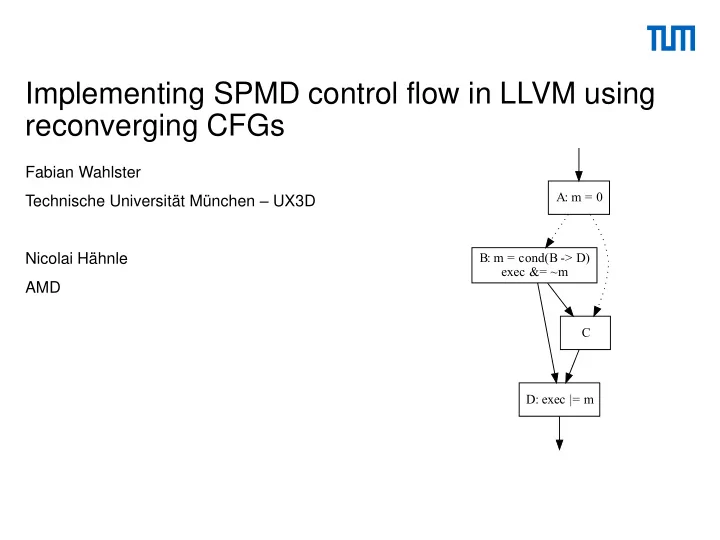

Implementing SPMD control flow in LLVM using reconverging CFGs Fabian Wahlster Technische Universität München – UX3D Nicolai Hähnle AMD
Divergence on wide SIMD Src : D. Lively and H. Gruen. “Wave Programming in D3D12 and Vulkan” Src: A. Sabne, P. Sakdhnagool, and R. Eigenmann “Formalizing Structured ControlFlowGraphs .” Fabian Wahlster | Vectorising Divergent Control-Flow for SIMD Applications 2
Converting thread-level code to wave-level ISA M. Mantor and M. Houston: AMD Graphic Core Next Architecture, Fusion 11 Summit presentation 3 Fabian Wahlster | Vectorising Divergent Control-Flow for SIMD Applications
Structurization in LLVM StructurizeCFG Unnecessary flow blocks pass 4 Fabian Wahlster | Vectorising Divergent Control-Flow for SIMD Applications
Reconverging CFGs Definition: • Every non-uniform terminator B (conditional branch) has exactly two successors • One of which post-dominates B secondary successor primary successor 5 Fabian Wahlster | Vectorising Divergent Control-Flow for SIMD Applications
Lowering Reconverging CFGs For each conditional non-uniform node N: • Virtual register m holds re-join mask for basic block N • Subtract m from the exec register to direct control flow to secondary successor • Add m the exec register at the beginning of the primary successor to re-join divergent threads • m must be correctly initialized to avoid unrelated data being merged into the execution mask Fabian Wahlster | Vectorising Divergent Control-Flow for SIMD Applications 6
Transforming to reconverging control flow OpenTree OT Approach: • Maintain open tree OT structure containing unprocessed open edges to reroute control flow towards the exit node by inserting new flow blocks Ordering: • Compute basic block ordering in which to process input CFG • Ordering is based on traversal of the input CFG • Any ordering is viable as long as the exit node comes last • Quality of reconverging CFG depends on the input ordering Fabian Wahlster | Vectorising Divergent Control-Flow for SIMD Applications 7
Open Tree Structure Processing nodes: • Nodes of the OT have sets of open Incoming and Outgoing edges that need to be processed parent • An outgoing edge (A, B) is closed if A has already been visited armed when B is being processed closed • A node can be closed if both sets are emptied by processing • Closed nodes are removed from the OT and their child nodes outgoing moved to its parent • Divergent nodes are called armed if one of the outgoing edges has already been closed Fabian Wahlster | Vectorising Divergent Control-Flow for SIMD Applications 8
Transforming to reconverging control flow Processing C… Input CFG Initialize OT Added A A → C → B → D Fabian Wahlster | Vectorising Divergent Control-Flow for SIMD Applications 9
Transforming to reconverging control flow Processing C… Input CFG Adding FLOW Output CFG A → C → B → D Fabian Wahlster | Vectorising Divergent Control-Flow for SIMD Applications 10
Transforming to reconverging control flow Reconverging CFG A : %cc_A = icmp eq i32 %in_A, 0 br i1 %cc_A, label % FLOW0 , label % C B : br label % D FLOW0 : %0 = phi i1 [ true, % A ], [ false, % C ] br i1 %0, label % B , label % D C : %cc_C = icmp eq i32 %in_C, 0 br i1 %cc_C, label % A , label % FLOW0 D : ret void Fabian Wahlster | Vectorising Divergent Control-Flow for SIMD Applications 11
Input Ordering Exit Condition Input CFG Depth First: Fabian Wahlster | Vectorising Divergent Control-Flow for SIMD Applications 12
Input Ordering Comparison Depth First: Breadth First: RPOT: Fabian Wahlster | Vectorising Divergent Control-Flow for SIMD Applications 13
Reconverging Control-Flow Graphs Contributions: • New SPMD vectorization approach • Simple and concise definition of Reconvergence for CFGs (weaker than structuredness) • Proof-of-Concept lowering algorithm and CFG transformation Properties: • Support for unstructured and irreducible input CFGs • Preserves uniform control flow • Retains CFGs that are already reconverging • Insert fewer new basic blocks than structurization (StructurizeCFG) Fabian Wahlster | Vectorising Divergent Control-Flow for SIMD Applications 14
Recommend
More recommend